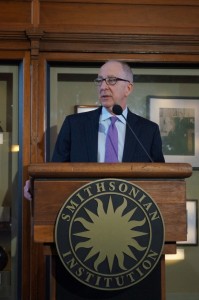March 11th, 2014
Cardiologist Tapped to Run the Smithsonian Institution
Larry Husten, PHD
A cardiologist has been chosen by the Smithsonian Institution’s Board of Regents to be the next leader of the Institution. David Skorton, who is currently the president of Cornell University, will be the Institution’s 13th Secretary, effective July 2015. He will be not only the first cardiologist but also the first physician to run the Smithsonian.
Before going to Cornell, Skorton had been the president of the University of Iowa from 2003 to 2006.
“David Skorton has demonstrated keen vision and skilled leadership as the president of two great American universities,” said the Chief Justice of the United States, John Roberts, Jr., who is also a board member of the Smithsonian. “His character, experience and talents are an ideal match for the Smithsonian’s broad and dynamic range of interests, endeavors and aspirations. I look forward to working with David to increase the impact of an incomparable American institution across the spectrum of arts, sciences, education, and culture.”
John McCarter, the chair of the Smithsonian Board, said that Skorton was chosen because he is a well-rounded, accomplished leader. “As a successful president of two universities, David has led complex organizations. He is an accomplished research scientist and a strong advocate for the arts and humanities, which make him an extraordinary fit for the Smithsonian.”
Skorton, who is 64, has been a successful fundraiser at both Cornell, where he raised more than $5 billion, and at the University of Iowa, where he raised more than $1 billion. He is also considered to be a strong supporter of industry–university partnerships.
As a cardiologist, Skorton’s research and clinical interests centered on congenital heart disease and applying computer analysis to cardiac imaging. Skorton was a co-editor, with his mentor Melvin Marcus, of Cardiac Imaging, a textbook that accompanied Braunwald’s Heart Disease, and became the editor of a later edition of the textbook when it became known as Marcus Cardiac Imaging.
On the Smithsonian Magazine website, Skorton answered a question about what attracted him to the Smithsonian job:
Number one, the fact that this is a fabulous interface with the public. On the mall, and across the country, and in the towns that have the affiliate museums, and around the world based on the Internet, it’s a way for them to almost palpably get their arms around these exhibits and this knowledge that’s here. And as a lifelong educator and physician, that interface of explaining things, learning things is really, really important to me. That’s one.
Number two, from a life in medicine, I’ve learned that the first thing a physician has to do—and I was a diagnostician, I’d like to think that I still am—is to be quiet and listen. Be quiet and observe. Be quiet and try to make sense of what I see. And this is a place that allows you to do that.
And I’m very passionate about trying to express that chance to do any sort of education, and you guys do a lot of it. Maybe more widespread than any entity I’ve ever worked with.

